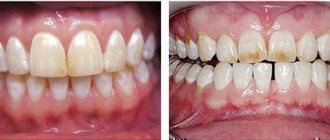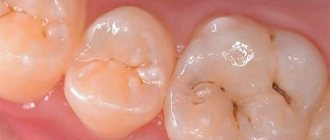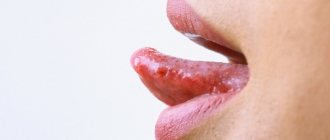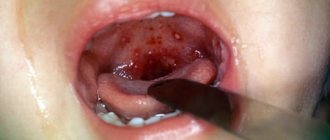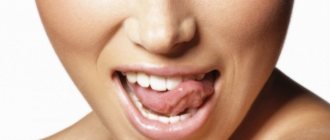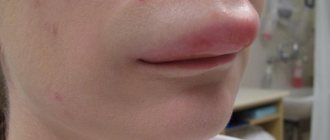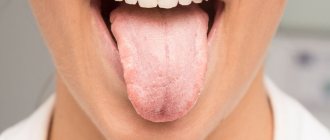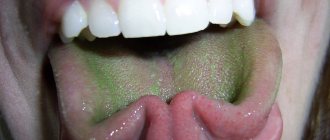What do suspicious red spots on the tongue mean and should you sound the alarm?
Light or dark red spots on the tongue indicate the onset of pathological processes in the oral cavity or even in the body as a whole. Suspicious changes are not necessarily a symptom of some dental disease - they often indicate problems in the cardiovascular system or digestive tract. To identify the true cause of deformation of mucosal tissue and the occurrence of accompanying unpleasant symptoms, you need to make an appointment with a specialist. This article will talk about why strange spots appear on the tongue, what they can mean and what to do in such a situation.
What does this mean?
Provoking a change in the usual color of the tongue can signal serious health problems.
In such a situation, people should not self-medicate, since incorrect actions or incorrectly selected medications can lead to the development of dangerous complications.
For thousands of years, language has been considered by doctors as an indicator of the state of the human body. If any changes occur to him, it means that the patient has problems.
When performing an oral examination, you need to pay attention to the following factors:
- presence of plaque;
- relief;
- shade and areas of plaque distribution;
- presence of an unpleasant odor;
- the presence of lesions, such as erosions or ulcers, acne, papillomas, etc.
Currently, in Asian countries, examination of the oral cavity is still included in the mandatory range of diagnostic measures.
Indian doctors, who have been studying this pathological condition for many years, were able to prove that blackening of the organ is a sign of diseases in the gallbladder or pancreas.
Also, the reason may lie in intestinal dysbiosis, suppression of the functionality of the adrenal glands and Crohn's disease.
Types of “spotty” rashes
The spots that appear on the surface of the tongue can have a wide variety of colors: from deep red to light pink, white and even yellow. The affected areas may not be visible on the surface or may slightly protrude above healthy tissue. Such neoplasms are also distinguished by localization: in some cases, the spots completely cover the organ, in others they are concentrated on the side, at the tip, closer to the larynx or even under the tongue. All these characteristics must be taken into account by the doctor and help him make the correct diagnosis.
Why do red spots appear on the tongue?
As for the condition of the epithelium, depending on the pathology present, the surface of the organ can be smooth or slightly rough, with clearly enlarged filiform papillae. Sometimes a person notices one large spot, and sometimes many of them appear at once; they can be scattered all over the back or concentrated in small clusters. Similar problems can appear in both a child and an adult, however, there are certain diseases that occur mainly in children, for example, Kawasaki disease - in this case, the pathology is usually diagnosed in children under 5 years of age1.
Another important criterion for assessing neoplasms is the intensity of their color. So, for example, the same red color can be saturated, light or very pale. But the whitish areas have a grayish or yellowish tint. Such a wide variety of characteristics and probable causes of the problem makes diagnosis very difficult, so if you have suspicious symptoms, you should immediately go to a specialist.
Associated symptoms for accurate diagnosis
In some cases, a strange reddish spot appears on the tongue, but the person does not experience any associated symptoms. In such a situation, the doctor will need to carry out additional diagnostic procedures to identify the causes of the defect. However, most often “spotting” is accompanied by other characteristic symptoms:
- soreness,
- discomfort while eating,
- numbness of the organ,
- burning sensation,
- the appearance of purulent ulcers,
- bad breath,
- spots on other areas of the mucous membrane,
- the formation of a dense plaque directly on the organ.
Pain, burning, numbness of the tongue may be a symptom of the disease.
Other accompanying symptoms include a general deterioration in condition, loss of strength, increased temperature - all this may indicate the rapid spread of infection in the body. But nausea, bloating, heartburn, and digestive problems most often result from problems in the gastrointestinal tract.
Dangerous symptoms and which doctor to contact
When black spots on a person’s tongue do not go away within two to three days, increase in size, new spots appear, and the temperature rises, you should go to the doctor.
The first thing you need to do is visit the dentist. If this nature of the problem is excluded, then the doctor will refer the sick person to the therapist’s office. You may need help from a specialist in gastroenterology or oncology.
The main method of diagnosing the disease is bacteriological culture of plaque to determine the type of pathogenic microflora in the mouth, donating blood for analysis. If there is a suspicion of problems with the gastrointestinal tract, a coprogram and ultrasound examination of the organs will be used.
Causes of pathology
There are quite a few potential causes for the appearance of red spots, but the most common situation leading to the occurrence of this symptom is injury to the organ. This could be accidental biting, damage from a denture or braces, too hard food, fish bones or sunflower seed husks, or sharp edges of a crown or filling. The spots may look like burns caused by drinking a hot drink or food. In addition, such neoplasms often become the result of disturbances in the functioning of the internal systems of the body. So, let's take a closer look at the most common reasons for encountering a similar symptom:
- allergies: food, medicinal or cosmetic irritants can lead to the appearance of suspicious rashes on the surface of the tongue,
- venereal diseases: the symptoms in question are especially characteristic of syphilis - small ulcers are concentrated on the front of the organ,
- viral infections: in this regard, the herpes virus is usually to blame. First, tiny bubbles with liquid appear on the mucous membrane, which quickly burst, and painful ulcers appear in their place. In this case, a person may experience severe itching and pain, especially when eating,
- stomatitis: damage to the mucous membrane, in which red spots may appear on the tongue, completely different in both shape and size,
Tongue allergies can cause rashes and swelling
“My husband once developed red spots on the back of his tongue, right in the middle. He noticed them when he took a sip of hot tea and was stunned by pain. At first there was one spot, they thought it was a burn. Then more of them appeared, and eventually the entire tongue became covered with some kind of rash. At this point I took him to the dentist. As a result, they diagnosed stomatitis, like a child’s, by God! They prescribed pills and rinses, everything healed quickly. By the way, the doctor said that most likely the burn caused the disease.”
ElenaD, Krasnodar, from correspondence on the women's forum
- pathologies of the digestive system and gastrointestinal tract: in such cases, inflammation of the filiform papillae is usually observed, which as a result increase in size. The symptom can be provoked by too spicy, sour, fatty or salty foods, as well as consumption of low-quality alcohol, stress, severe emotional overexcitation,
- oncology of oral tissues: the beginning of the formation of a malignant tumor can be indicated by small bright spots and ulcers dispersed throughout the oral mucosa, including on the tongue,
- anemia: a deficiency of B vitamins in the body leads not only to the appearance of clearly visible red areas on the organ, but also to the development of heartburn, nausea, depression,
- glossitis of a certain type: spots with a whitish edge have an uneven shape and size, constantly change, disappear and appear in different parts of the organ. The disease, widely known as “geographical” tongue, often occurs in children, including infants, who are already born with characteristic spots,
- herpes zoster: this disease is typical only for adults, since it is practically not diagnosed in children. The rash covers the entire surface of the tongue; the person’s temperature rises, severe itching and burning occur.
The photo shows glossitis of the tongue.
As can be seen from all of the above, red spots most often become the result of certain disorders in the functioning of internal organs. However, for the appearance of this symptom, some additional factor is usually required, which can be an unbalanced diet, constant consumption of foods that irritate the mucous membranes, regular mechanical damage, smoking, frequent consumption of low-quality alcohol, poor hygiene, weakened immunity, serious stress and excessive physical exercise.
How is therapy carried out?
Treatment of the symptom in question first requires identifying the source of the problem, that is, the primary cause. If the change in the condition of the tongue is the result of an injury or allergy, then the patient needs to reconsider his diet, eliminate the allergen and be more attentive to the condition of the oral cavity, try not to injure the mucous membrane with foreign objects.
If the culprit is a certain disruption in the functioning of the internal systems, then you cannot do without the help of a highly specialized doctor - a general practitioner or dentist, depending on who you contacted, will redirect you to a gastroenterologist, endocrinologist or immunologist.
An ultrasound will help determine the cause of the pain.
But for symptomatic treatment, it is advised to resort to traditional medicine. Many medicinal herbs have long been famous for their antiseptic, soothing and wound-healing properties. Just remember: the use of all kinds of infusions and decoctions for mouth rinsing is allowed only with the consent of the attending physician. Additionally, experts prescribe antifungal drugs, vitamin complexes and immunomodulators. If the tongue is very painful, painkillers must be prescribed.
Preventive measures
To prevent any disease of the tongue, it is important to take the most responsible approach to oral hygiene, monitor the cleanliness of the organ, brush your teeth at least twice a day with a brush and toothpaste, and rinse your mouth every time after a meal. In addition to these basic rules, you must adhere to other important recommendations from experts:
- try to eliminate too spicy, salty, sour and sweet foods from your diet, eat more vegetables and fruits,
- give up bad habits, such as smoking and uncontrolled drinking,
- periodically take multivitamin complexes to strengthen the immune system,
- spend more time in the fresh air, lead a physically active lifestyle,
- systematically visit the dentist for routine examinations.
When you find strange burgundy or light pink spots on the surface of your tongue, the main thing is not to panic. There are a great many reasons for this phenomenon, and to make an accurate diagnosis, you definitely cannot do without an examination by a specialist. If you notice any new growths on an organ, even if they do not hurt or cause discomfort, be sure to make an appointment with a doctor.
- Kargaltseva, N. M. The oral cavity is an important biotope of the human body, 2001.
Treatment of spots
Therapy for altered mucosa depends on the disease that caused it. Burns and minor injuries will gradually go away on their own. Treatment of spotting caused by diseases of internal organs consists of combating the cause. Only a doctor can diagnose the disease and conduct the necessary research.
A gastroenterologist will help eliminate problems with the gastrointestinal tract; a cardiologist, therapist or hematologist will help eliminate problems with the cardiovascular system. Stomatitis, herpes, glossitis will be cured by a dentist. Geographic tongue or “bald spots” cannot be cured, since the taste buds are not able to recover (we recommend reading: what to do if the papillae on the tongue are inflamed?).
READ ALSO: geographic tongue in a child: causes, photos and treatment
Anti-inflammatory and antihistamines
- At the initial stage, you can cope with tongue spotting using medications that have an anti-inflammatory effect. To treat stomatitis, Metrogyl Denta and Cholisal are used, which provide an analgesic effect.
- Additional aseptic treatment will be provided by Miramistin and Stomatidin.
- To cure an allergy, you must avoid contact with the allergen. The patient is prescribed antihistamines and restorative drugs: Claritin, Erius, Suprastin, Tavegil, Zyrtek, etc.
Hygiene of the tongue and entire oral cavity
Brushing your teeth has become a part of our everyday life, but brushing your tongue has also been a well-known thing for a long time. In Rus' this has been done since the 15th century, using scrapers made of ivory or silver. Today, brushes with rubber tips or special models of toothbrushes and toothpaste are used for this purpose.
Thorough brushing of your teeth, cheeks and tongue eliminates unpleasant odors and helps you taste food more subtly.
Rinse
Rinsing the mouth with decoctions and infusions of herbs is the oldest method of cleansing it from pathogens and freshening breath. Rinsing promotes the healing of microtraumas, protects teeth from caries, and mucous membranes from inflammation. There are a huge number of rinses designed for both the prevention and treatment of diseases.

